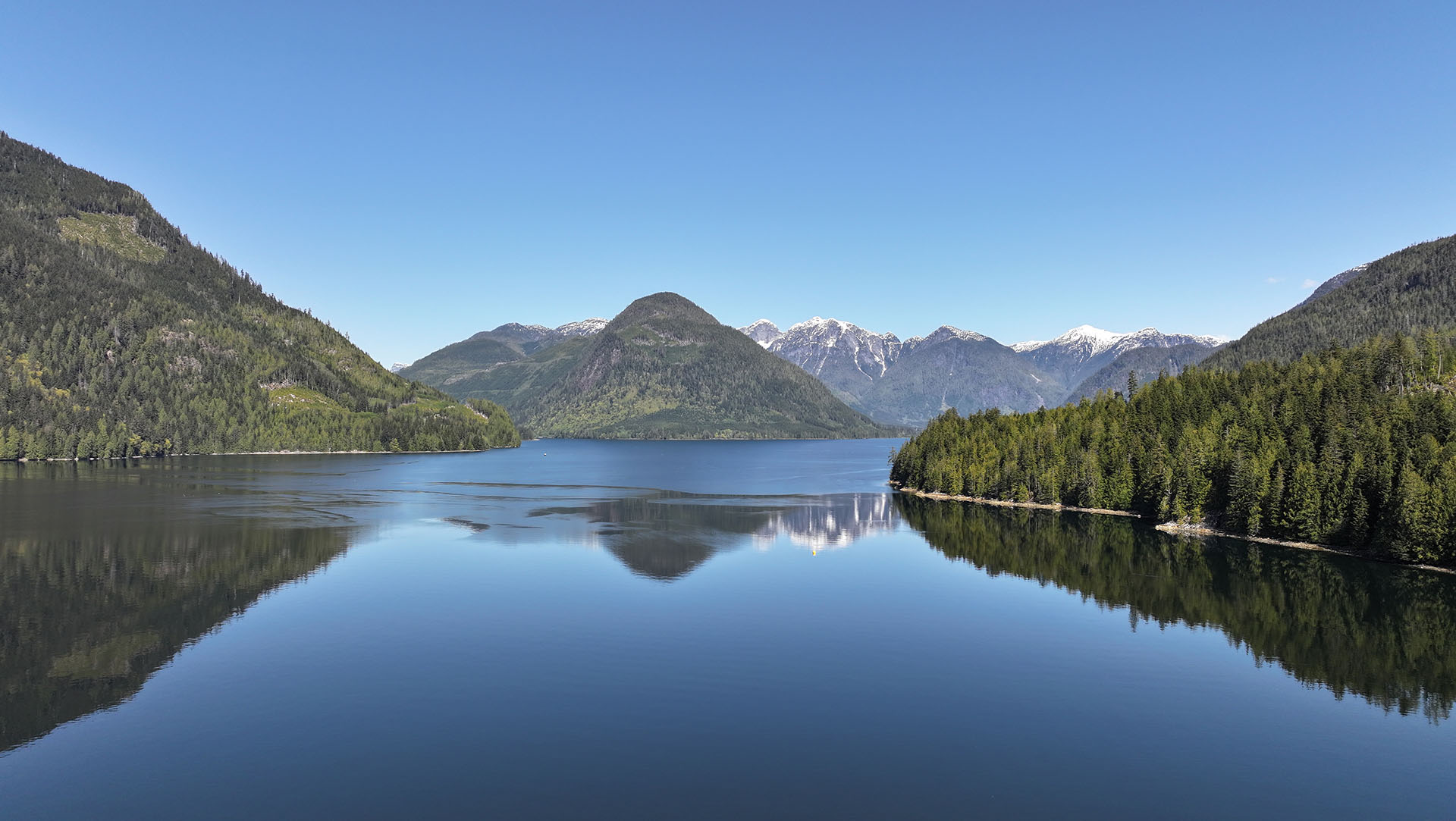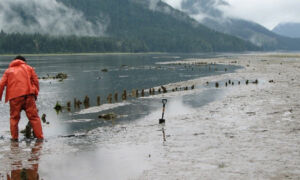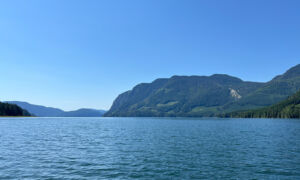Estimated Reading time

5 Mins
Kwiakah’s Centre for Excellence: A “Home Away from Home” for Guardians, Researchers
In the heart of their newly-declared Special Forest Management Area, the Kwiakah are investing in facilities for studying regenerative forestry and blue carbon sequestration.


In Phillips Arm, an inlet stretching into the mountainous south-central coast of British Columbia, Kwiakah First Nation is preparing to open a new Centre for Excellence: a floating research facility with accommodations and amenities to support up to 16 scientists and stewardship staff working in the remote region.
Set to open in spring 2025, the Centre for Excellence features an accommodation barge and research lab, a float house to support the Nation’s four-person Guardian team, and one-hectare test farm for kelp and seaweed – all connected by docks and anchored near Kwiakah’s Matsayno reserve lands, in the heart of their core territory.
For researchers working in the southern reaches of the Great Bear Rainforest, the Centre will offer comfortable bedrooms and living space for rent, along with fully-equipped wet and dry labs, computer banks, and fresh water supplied by desalination equipment – “everything they need,” says Kwiakah Band Manager Frank Voelker.
[We’re] taking out the commute and really extending the time researchers can spend here – where the work needs to be done.
The facility is powered by solar energy, with diesel generators that can provide extra power on dark days or when visitors need to run multiple appliances simultaneously.
With the closest urban centre – Campbell River – a 90-minute boat ride away, the Centre is “taking out the commute and really extending the time researchers can spend here – where the work needs to be done,” says Frank, who worked closely with Kwiakah leaders to procure the equipment and plan $1 million in renovations and upgrades to transform a decommissioned fish farm into a research hub.
Applying Regenerative Forestry Techniques

The Kwiakah are part of the Liǧʷiłdax̌ʷ group of First Nations – which also includes the Wei Wai Kum and We Wai Kai – the southernmost group of Kwakwa̱ka̱ʼwakw peoples. With 19 members, the Kwiakah are a small and resilient First Nation that works tirelessly with trusted staff and partners to steward their 86,000-hectare core territory in the Phillips and Frederick Arm and the surrounding lands.
Earlier this year, the Nation announced the creation of the M̓ac̓inuxʷ Special Forest Management Area (SFMA), which includes nearly 7,865 hectares of land surrounding Phillips Arm, most of which was previously logged. The SFMA was created through an Order in Council, following Kwiakah’s purchase of harvest rights from Interfor, and effectively doubles the amount of protected land in Kwiakah territory.

“By creating the M̓ac̓inuxʷ SFMA, we are asserting our inherent responsibilities and creating an Indigenous-led conservation economy that will steward and heal our territory while allowing our people to thrive,” said Kwiakah Chief Steven Dick in a news release. “We hope that, as this work takes hold, it can also empower other Indigenous communities around the world with innovative and self-determined conservation models to counter-balance extractive industrial systems, protect nature and provide a bold solution to climate change.”
Within the bounds of the M̓ac̓inuxʷ SFMA, the Kwiakah and the Province have prohibited commercial logging, and the Nation is applying its knowledge of regenerative forestry to begin restoring the land to its pre-industrial state – a process that will take many, many years.
Through partnerships with universities and researchers like Dr. Suzanne Simard, forest ecologist and author of Finding the Mother Tree, the Kwiakah are developing test plots and contributing their knowledge of what a healthy forest ecosystem should look like.
We can help this mature, second growth forest to present old growth characteristics and, in turn, increase biodiversity.
“This is supposed to be a forest, but it’s a monoculture. This area will take between 200 – 300 years to get back to its glory,” says Frank. To help the process along, the Kwiakah are researching and testing different treatments – like thinning, planting, and growing cover crops like berry bushes. “We can help this mature, second growth forest to present old growth characteristics and, in turn, increase biodiversity.”

With regenerative forestry, the Kwiakah are creating new job opportunities in forest stewardship. In the coming years, the Nation plans to generate revenue from ecosystem services and carbon credits, which will accelerate the transition from an extractive economy to a conservation economy that aligns with Kwiakah values and practices.
“We as Kwiakah people have a vision of the future — where nən grizzly bears and their cubs roam through the mossy, misty forests of our territory, finding a bounty of berries, roots, and fish to eat, and where Kwiakah youth only know their forests as protected and abundant,” says Chief Dick.
The Centre for Excellence supports this vision, providing a home base for Kwiakah’s Guardian and stewardship team, as well as infrastructure to support research on regenerative forestry and carbon sequestration.
We as Kwiakah people have a vision of the future — where nən grizzly bears and their cubs roam through the mossy, misty forests of our territory, finding a bounty of berries, roots, and fish to eat, and where Kwiakah youth only know their forests as protected and abundant.
Testing Blue Carbon Sequestration

Through their work with research partners on regenerative forestry, the Kwiakah have established models to account for the carbon stored in trees, plants, and soil, which will support the sale of carbon credits and ecosystem services. With the Centre for Excellence, the Nation is now beginning to explore opportunities in kelp and seaweed cultivation – for processing or carbon sequestration.
Since acquiring the former fish farm site – following the closure of open-net pen salmon farming in the Discovery Islands – the Kwiakah have repurposed the docks and cage system into a one-hectare kelp test farm.
The Nation has partnered with North Island College and built relationships with nearby producers, like Cascadia Seaweed, to learn about kelp cultivation and test the impacts of kelp and seaweed farming in the ecosystem.

Given that the test farm is about 70 kilometres away, by water, from the nearest processing facility on Quadra Island, transporting cultivated kelp would be costly, Frank says. However, if there’s an opportunity to process kelp and seaweed on site, or to allow kelp and seaweed to grow and die naturally, the test farm could, enrich the ecosystem by creating wildlife habitat and storing carbon in the seafloor.
“You grow it and then you just leave it be,” says Frank. “You just have to find a way to verify the carbon and monetize it. Then you don’t have to worry about the logistics of growing in areas that are really, really remote. You just have to make sure you follow scientific protocols and work with Elders to get an idea of the historic abundance of kelp, so you don’t go beyond that.”
Kwiakah First Nation accessed $438,828 in economic development funds from Coast Funds in 2023 towards the development of the Kwiakah Centre for Excellence & Kelp Test Farm.
